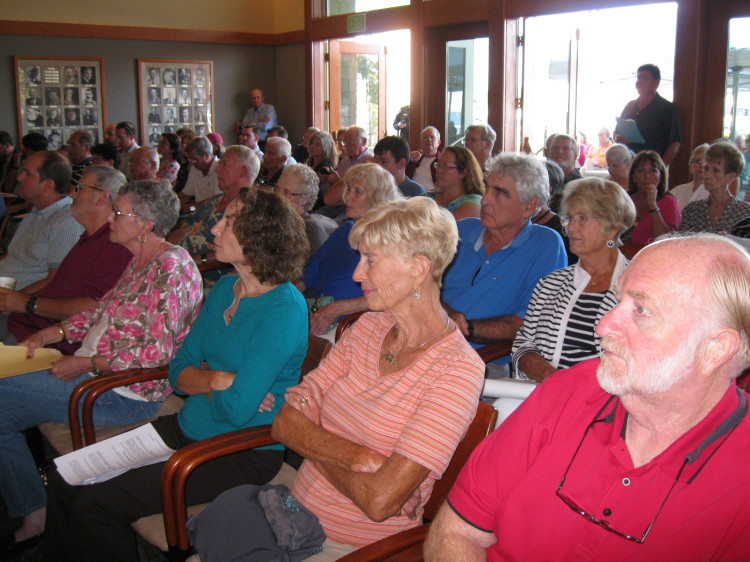 Residents at Tuesday Council Meeting waiting for an opportunity to voice their views on traffic lights for Third and Fourth Streets
Residents at Tuesday Council Meeting waiting for an opportunity to voice their views on traffic lights for Third and Fourth Streets
Tuesday night, the City Council voted down a recommendation that the city install traffic lights at selected intersections along the Third/Fourth corridor as away to slow traffic and increase safety. The corridor is the primary route commuters use to get to the bridge to North Island Navel Air Station, as well as make their way back to the bridge.
The fear was that adding traffic lights would only divert traffic onto other streets. “It would lead to hemorrhaging and cause traffic to bleed out,” Mayor Casey Tanaka said.
The one exception was the signal proposed for Fourth and Alameda. It was approved with restrictions on right hand turns during peak hours. The rest of the time it would be a four way stop. This would have the potential to slow traffic on Fourth the way the light at Orange slows the traffic on Third, proponents argued.
The vote was advisory. Following additional engineer studies, Caltrans will ultimately decided what to do about traffic in the corridor.
The city relinquished jurisdiction over those streets when the bridge was completed in 1969. At that point the Third and Fourth Streets became in effect a state highway careening though a residential neighborhood.
We are giving Caltrans a menu of things they say they wont do, said Councilman Mike Woiwode. In doing so it would force Caltrans hand. In the past it has resisted any safety measures, including hawk lights the city has suggested.
Some at the meeting suggested that the state agency had become more amenable, but many, including Woiwode remained skeptical. He also pointed out that, we not making a forever decision. Were deciding what we want to study further.
After dismissing the idea of traffic lights anywhere but Alameda, the council went down the list of Fehr and Peers recommendations and adopted every other conceptual improvement, with a few modifications:
Raised crosswalks at H and I Avenues intersections on Third and Fourth.
Speed tables on Third west of D, on Fourth east of A and west of Glorietta, on Third and Fourth at F Avenue.
Flashing beacons at H and I Avenues on Fourth; at F Avenue on Third and Fourth; on B Avenue at Third and Fourth.
Curb extensions wherever feasible all along the corridor.
Modifications to intersection of Palm and Fourth; Pomona and Third, Pomona and Fourth; Glorietta Place and Pomona
Keep clear pavement markings at Third and C Avenue; Fourth and D Avenue.
Partial closure of A Avenue and Pomona Avenue to prohibit left turns onto A Avenue.
While many curse the congestion all along Third in the early morning and along Fourth in the late afternoon, traffic lights quickly became a nonstarter. The issue brought an overflow crowd to council chambers, many of whom stayed to the bitter end. The council didnt vote until 9pm.
Before taking up the recommendations, Mayor Tanaka called for an informal vote of people at the meeting. Fourteen people and 61 were opposed. He then asked how many people would support the recommendations without the lights. Thirty-six hands shot up.
Despite some support for the lights in the chamber only three people stepped forward to voice their support. T he parents of Frankie Slattery, the youth who suffered a serious head injury while crossing Fourth Street at B Avenue on his bike last year, supported the additional lights on Third and Fourth Streets.
Frankie’s father, Tom, told the council, After 50 years of doing nothing – do something. If not the lights the next appropriate level.
Councilman Richard Bailey with Transportation Commission Chair Patrick Garahan
The only other person who stepped forward to voice support was Chair Patrick Garahan, transportation commission chair – Weve been looking at this for two and half years, he told the council. We know people are not happy with our recommendations, but we need this to proceed. [If its not accepted] weve wasted two and one half years.”
The failure of past councils not to act and the safety and congestion issues along the corridor was not lost on Councilman Richard Bailey: We have done nothing since 1969. If we dont do something now, youll be back later in 2016 asking us to do something about traffic.
Resolving traffic issues along the Third/Fourth Street Corridor took up most of the meeting. Still the council did take up a few other issues including, giving the Historical Resources Commission oversight on the Ferry Booth restoration and agreeing to consider Councilwoman Carrie Downeys request to discuss whether the free summer shuttle should be a year around service.
It appointed Akshay Sateesh and Norm Funk to the Parks and Recreation Commission, and Steven Kim Moreno to the Street Tree committee. All three will replace commissions who left before their terms expired.





